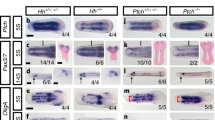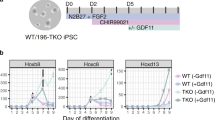Abstract
The vertebral column exhibits segmentation and regionalization along the antero-posterior axis. During embryogenesis, the rhythmic production of the precursors of the vertebrae, the somites, imposes a segmented aspect to the spine, whereas the spine's regional differentiation is controlled by Hox genes1,2. Here we show that in the paraxial mesoderm, Hoxb genes are first activated in a temporal collinear fashion in precursors located in the epiblast lateral to the primitive streak. Our data suggest that collinear activation of Hoxb genes regulates the flux of cells from the epiblast to the streak and thus directly controls the establishment of the genes' characteristic nested expression domains in the somites. This suggests that establishment of the spatial co-linearity in the embryo is directly controlled by the Hox genes themselves.
This is a preview of subscription content, access via your institution
Access options
Subscribe to this journal
Receive 51 print issues and online access
$199.00 per year
only $3.90 per issue
Buy this article
- Purchase on Springer Link
- Instant access to full article PDF
Prices may be subject to local taxes which are calculated during checkout




Similar content being viewed by others
References
Kmita, M. & Duboule, D. Organizing axes in time and space; 25 years of colinear tinkering. Science 301, 331–333 (2003)
Krumlauf, R. Hox genes in vertebrate development. Cell 78, 191–201 (1994)
Dolle, P., Izpisua-Belmonte, J. C., Falkenstein, H., Renucci, A. & Duboule, D. Coordinate expression of the murine Hox-5 complex homoeobox-containing genes during limb pattern formation. Nature 342, 767–772 (1989)
Gaunt, S. J., Sharpe, P. T. & Duboule, D. Spatially restricted domains of homeo-gene transcripts in mouse embryos: relation to a segmented body plan. Development 104, 169–179 (1988)
Graham, A., Papalopulu, N. & Krumlauf, R. The murine and Drosophila homeobox gene complexes have common features of organization and expression. Cell 57, 367–378 (1989)
Kessel, M. & Gruss, P. Homeotic transformations of murine vertebrae and concomitant alteration of Hox codes induced by retinoic acid. Cell 67, 89–104 (1991)
Wellik, D. M. & Capecchi, M. R. Hox10 and Hox11 genes are required to globally pattern the mammalian skeleton. Science 301, 363–367 (2003)
Deschamps, J. & van Nes, J. Developmental regulation of the Hox genes during axial morphogenesis in the mouse. Development 132, 2931–2942 (2005)
Wacker, S. A., Jansen, H. J., McNulty, C. L., Houtzager, E. & Durston, A. J. Timed interactions between the Hox expressing non-organiser mesoderm and the Spemann organiser generate positional information during vertebrate gastrulation. Dev. Biol. 268, 207–219 (2004)
Forlani, S., Lawson, K. A. & Deschamps, J. Acquisition of Hox codes during gastrulation and axial elongation in the mouse embryo. Development 130, 3807–3819 (2003)
Stern, C. D. in Gastrulation: From Cells to Embryos (ed. Stern, C. D.) 219–232 (Cold Spring Harbor Laboratory Press, Cold Spring Harbor, 2004)
Garcia-Martinez, V., Alvarez, I. S. & Schoenwolf, G. C. Locations of the ectodermal and nonectodermal subdivisions of the epiblast at stages 3 and 4 of avian gastrulation and neurulation. J. Exp. Zool. 267, 431–446 (1993)
Nicolet, G. Avian gastrulation. Adv. Morphog. 9, 231–262 (1971)
Greer, J. M., Puetz, J., Thomas, K. R. & Capecchi, M. R. Maintenance of functional equivalence during paralogous Hox gene evolution. Nature 403, 661–665 (2000)
Stewart, C. L., Schuetze, S., Vanek, M. & Wagner, E. F. Expression of retroviral vectors in transgenic mice obtained by embryo infection. EMBO J. 6, 383–388 (1987)
Stamataki, D., Ulloa, F., Tsoni, S. V., Mynett, A. & Briscoe, J. A gradient of Gli activity mediates graded Sonic Hedgehog signaling in the neural tube. Genes Dev. 19, 626–641 (2005)
Duboule, D. & Morata, G. Colinearity and functional hierarchy among genes of the homeotic complexes. Trends Genet. 10, 358–364 (1994)
Tam, P. P. & Tan, S. S. The somitogenetic potential of cells in the primitive streak and the tail bud of the organogenesis-stage mouse embryo. Development 115, 703–715 (1992)
Hamburger, V. & Hamilton, H. L. A series of normal stages in the development of the chick embryo. Dev. Dyn. 195, 231–272 (1992)
Henrique, D. et al. Expression of a Delta homologue in prospective neurons in the chick. Nature 375, 787–790 (1995)
Bel-Vialar, S., Itasaki, N. & Krumlauf, R. Initiating Hox gene expression: in the early chick neural tube differential sensitivity to FGF and RA signaling subdivides the HoxB genes in two distinct groups. Development 129, 5103–5115 (2002)
Chapman, S. C., Collignon, J., Schoenwolf, G. C. & Lumsden, A. Improved method for chick whole-embryo culture using a filter paper carrier. Dev. Dyn. 220, 284–289 (2001)
Yang, X., Dormann, D., Munsterberg, A. E. & Weijer, C. J. Cell movement patterns during gastrulation in the chick are controlled by positive and negative chemotaxis mediated by FGF4 and FGF8. Dev. Cell 3, 425–437 (2002)
Niwa, H., Yamamura, K. & Miyazaki, J. Efficient selection for high-expression transfectants with a novel eukaryotic vector. Gene 108, 193–199 (1991)
Acknowledgements
We thank S. Abmayr, R. Krumlauf and D. Wellik for comments on the manuscript; X.-S. Yang and C. Weijer for sharing their expertise in fate mapping and for discussions; members of the Pourquié laboratory for sharing reagents and for discussions; C. Tomomori-Sato and S. Sato of the Conaway laboratory for discussions; and S. Esteban for artwork. This work was supported by the Stowers Institute for Medical Research and the NIH. O.P. is a Howard Hughes Medical Institute Investigator.
Author information
Authors and Affiliations
Corresponding author
Ethics declarations
Competing interests
Reprints and permissions information is available at npg.nature.com/reprintsandpermissions. The authors declare no competing financial interests.
Supplementary information
Supplementary Figure 1
Double whole mount in situ hybridization of Sox 2 and HoxB7. Onset of Hoxb7 expression (blue) is in the epiblast adjacent to the primitive streak and this Hox domain is at a distance from the neural territory marked by Sox2 (red). (PDF 189 kb)
Supplementary Tables
Supplementary Tables 1–3 show the result of each experiment in which caudal-most and rostral-most distribution of labeled cells by Hox-reporter construct were scored by somite number along anterior-posterior axis. The stage and area of each embryo at which graft and/or electroporation were carried out are also indicated. Supplementary Table 1 is a summary of Hox electroporation and graft experiments. Supplementary Table 2 is a summary of successive Hox electroporation experiments. Supplementary Table 3 is a summary of Heterochronic graft experiments. (PDF 31 kb)
Supplementary Methods
This file contains additional details of the methods used in this study. (DOC 27 kb)
Rights and permissions
About this article
Cite this article
Iimura, T., Pourquié, O. Collinear activation of Hoxb genes during gastrulation is linked to mesoderm cell ingression. Nature 442, 568–571 (2006). https://doi.org/10.1038/nature04838
Received:
Accepted:
Published:
Issue Date:
DOI: https://doi.org/10.1038/nature04838
This article is cited by
-
Morphogen gradient orchestrates pattern-preserving tissue morphogenesis via motility-driven unjamming
Nature Physics (2022)
-
A TALE/HOX code unlocks WNT signalling response towards paraxial mesoderm
Nature Communications (2021)
-
Characterising open chromatin in chick embryos identifies cis-regulatory elements important for paraxial mesoderm formation and axis extension
Nature Communications (2021)
-
HIRA stabilizes skeletal muscle lineage identity
Nature Communications (2021)
-
Human reconstructed kidney models
In Vitro Cellular & Developmental Biology - Animal (2021)
Comments
By submitting a comment you agree to abide by our Terms and Community Guidelines. If you find something abusive or that does not comply with our terms or guidelines please flag it as inappropriate.



